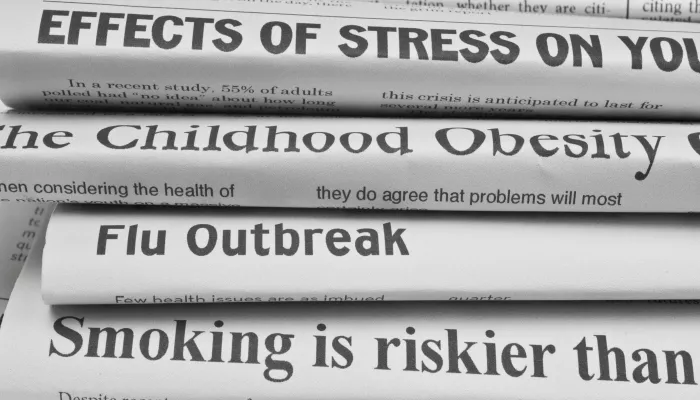While consumption of soda and other sugary drinks among young children in California is starting to decline, a new study released today shows an alarming 8 percent spike among adolescents, the biggest consumers of these beverages.
Based on interviews with over 40,000 California households conducted by the California Health Interview Survey (CHIS), the study, Still Bubbling Over: California Adolescents Drinking More Soda and Other Sugar-Sweetened Beverages, provides a comprehensive look at youth (2- to 17-year-olds) consumption of sugary drinks, charting consumption patterns from 2005-2007 to 2011-2012. The study, which also provides county-by-county youth consumption rates, was produced collaboratively by the UCLA Center for Health Policy Research and the California Center for Public Health Advocacy (CCPHA).
The most encouraging finding was the dramatic drop in the proportion of young children drinking sugary beverages daily over the seven-year period. Only 19 percent of 2- to 5-year-olds drink a sugary beverage daily, a 30 percent decline from the 2005-2007 reporting period. Among 6- to 11-year-olds, 32 percent were daily consumers in 2011-12, representing a 26 percent drop since 2005-2007.
Of greatest concern, however, is the significant rise among the biggest consumers of sugary drinks – adolescents (12- to 17-year-olds). Today, a full 65 percent of California adolescents drink sugary beverages daily, an 8 percent climb since 2005-2007. And while the study’s authors point out that roughly the same proportion of these youth are drinking soda, 23 percent more are consuming energy and sports drinks every day.
“California has made real progress in reducing the consumption of sugary beverages among young children,” says Dr. Susan Babey, the report’s lead author. “But teens are in trouble. Soda or sports drinks should be an occasional treat, not a daily habit. If this trend isn’t reversed there may be costly consequences for teens, their families and the health care system in the form of increased obesity and diabetes.”
Although the study does not directly examine the causes for the sugary spike among teens, Dr. Harold Goldstein, CCPHA’s executive director, suggests one clear reason.
“As parents learn more about the harm from consuming sugary drinks, they are limiting how much their children drink. Teens, however, are more independent, making them an ideal target for beverage companies that spend hundreds of millions of dollars marketing sugary drinks to them, including deceptively healthy-sounding beverages like sports drinks and vitamin water. We may not be able to protect teens everywhere but we should at least close the loophole in state law that allows beverages companies to sell sugary sports drinks on middle and high school campuses.”
According to researchers, sugary drinks are the largest source of added sugar in the diets of children and adolescents and a significant contributor to total caloric intake. And unlike any other product that children consume in large quantities, sodas offer no nutritional value. Nearly 40 percent of California youth are overweight, and one-third of all children born in 2000, including half of Latino and African-American children, will develop diabetes sometime in their lives.
Mirroring the overall youth picture, consumption dropped across ethnic groups for young children (2- to 11-year olds) but rose significantly for adolescent Latinos, Asians and African-Americans. Among African-American adolescents, 74 percent reported drinking at least one sugary beverage a day, a 14 percent rise from 2005-2007. Latino adolescents trailed closely behind at 73 percent.
The most dramatic growth in consumption, 31 percent, was reported by Asian adolescents, who climbed from one of the lowest levels among ethnic groups of 48 percent to 63 percent reporting drinking at least one sugary beverage a day.
Comparing the 2005-2007 reporting cycle to 2011-2012, the statewide figures for all youth combined show an impressive 11 percent drop in consumption, with 41 percent of youth drinking a sugary beverage a day. Nine counties, however, had more than half of their youth drinking at least one sugary beverage a day, with King (60 percent) and Fresno (58 percent) counties showing the highest levels. Lake County had the largest percent change increase (36 percent), while Ventura County showed the greatest decline (37 percent).
“Soda and other sugary drinks contribute half a billion empty calories a day to California’s costly childhood obesity crisis,” explains Dr. Robert Ross, president and CEO of The California Endowment, which funded the study. “We have to redouble our efforts to protect our children, especially adolescents and children of color, from the unbridled marketing of high calorie drinks that is drowning our kids in sugar.”
View statistics on consumption in individual counties, by type of drink and by age group.
Additional Information
The UCLA Center for Health Policy Research (CHPR) is one of the nation’s leading health policy research centers and the premier source of health policy information for California. UCLA CHPR improves the public’s health through high quality, objective, and evidence-based research and data that informs effective policymaking. UCLA CHPR is the home of the California Health Interview Survey (CHIS) and is part of the UCLA Fielding School of Public Health and affiliated with the UCLA Luskin School of Public Affairs.
The California Center for Public Health Advocacy (CCPHA) is an independent, nonpartisan, nonprofit organization at the forefront of solving the obesity and diabetes epidemics by advocating for groundbreaking policies that build a healthier California.
The California Endowment, a private, statewide health foundation, was established to expand access to affordable, quality health care for underserved individuals and communities. The Endowment challenges the conventional wisdom that medical settings and individual choices are solely responsible for people's health. The Endowment believes that health happens in neighborhoods, schools, and with prevention.




